Reading Clara Fernández-Vara’s “Number of Players” section helped me to develop an initial, concrete idea of the standard ways for a single player, or multiple players, to interact with one another and the game they play. The examples given make a lot of sense and do build a good overall model for categorizing games by the “number of players.” After all, most games these days – both mainstream, triple-A and indie games – have settled into pretty standard styles of number-of-players gameplay. Genres like “multiplayer” and “singleplayer,” or “co-op” and “competitive” exist for a reason, of course.
But, just for fun, I wanted to think about examples of things that bend these rules and may lie somewhat outside the seven main categories Fernández-Vara described – or at least combine and remix them. Is there any way to still innovate past these relatively rigid configurations? The answer is a resounding, enthusiastic “yes!”
Speedrunning is one sort of situation where the line between some of the “number of players” categories gets blurred. The core philosophy of speedrunning is purely competitive: the goal of a speedrunner is to be the one person who has beaten a game of choice in the fastest possible time, ahead of everyone else. Yet, the games that are speedran are traditionally single-player games, where it’s just one player and their game. Think of games like Super Mario Bros. or Super Mario 64, which have some of the most well-known speedrunning scenes. Here you have a case of multiple people competing with one another for the fastest completion times in games played by a single person, where it’s technically possible for none of the players to ever interact with one another (beyond seeing someone else’s name on a public leaderboard online).
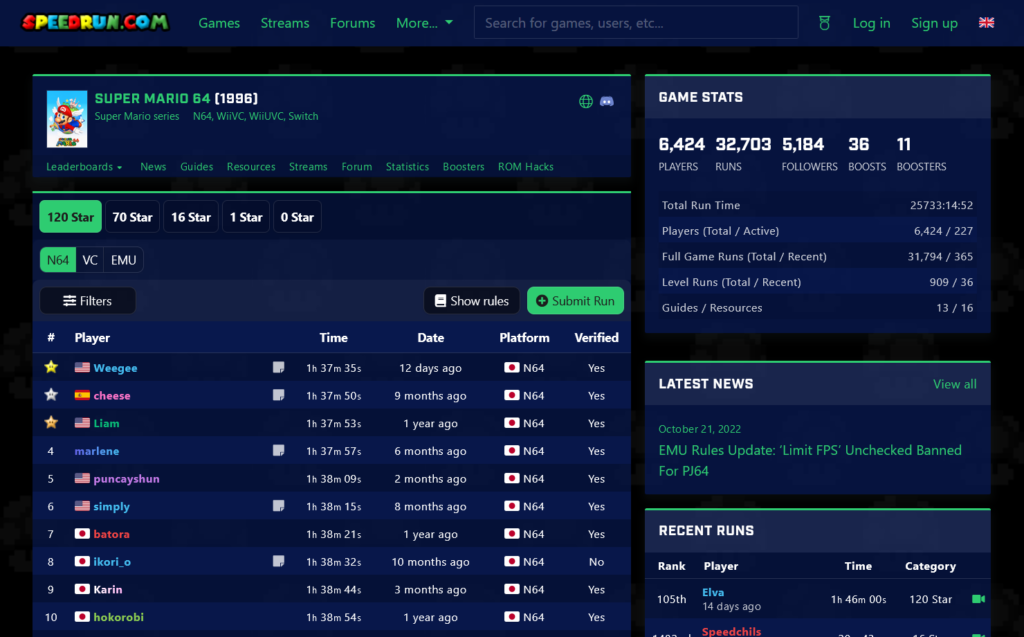
Further complicating this player configuration is the fact that speedrunning is actually a collaborative effort, too. Within their communities, speedrunners for a game constantly share new tricks and routes with one another in an effort to increase the skill ceiling and potential for their games. Top speedrunners for a game will sometimes spend hours, days, or weeks labbing and sharing potential new strategies with one another, even though they’re technically supposed to be in direct competition with one another. In fact, communities will often name notable new tricks after the person who discovered them in honor of their contribution to the scene. Despite the competitive nature of trying to achieve the fastest run of a game, speedrunners also collaborate with the common goal of finding ever faster ways to master their craft. Thus, speedrunning is also sort of its own metagame involving multiple people playing single-player games simultaneously and competing with one another, while also working together at the same time. It doesn’t quite fit into any single “number of players” configuration that Fernández-Vara described. Rather, it’s a unique combination of multiple concepts.
If you’d like to learn more about how much collaboration can actually go into speedrunning, I recommend this video: https://www.youtube.com/watch?v=oHg4oTMu5Yc, a documentary on the Super Mario Bros. speedrunning community’s quest for absolute perfection. Or, look up a “World Record History of [Game]” video. There are a lot of good ones out there!

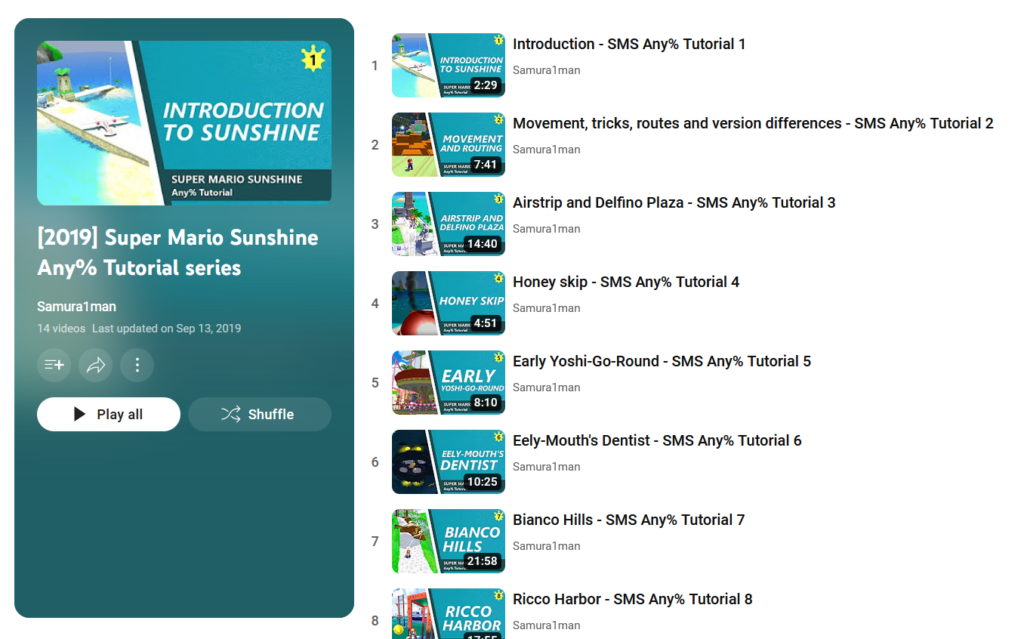
In 2014, an Australian programmer hooked up a system on the streaming site Twitch.tv, wherein any people watching could directly control a streamed game by sending simple messages in the chat. That game was the 1996 Gameboy classic Pokemon Red, which is a game traditionally played by a single person. All stream viewers simultaneously controlled a single avatar by sending messages simulating the inputs a player would make on their Gameboy, like “up,” “down,” “A,” “B,” etc.
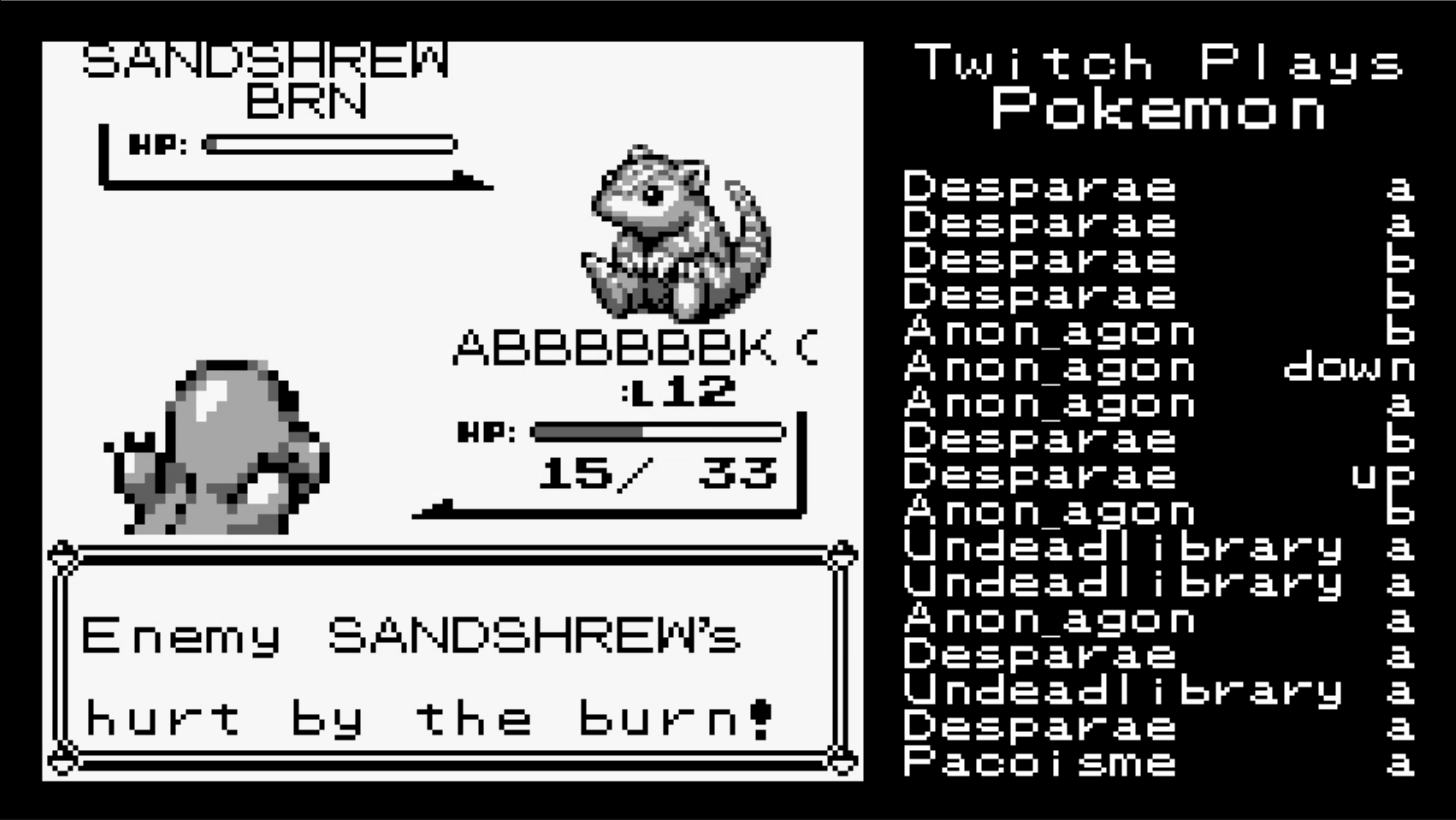
The goal was for each person to work together and beat the game at the same time. The important thing to note is that every single input was counted and inputted into the Pokemon Red game. What initially was a simple experiment ballooned into something extraordinary as its popularity grew and word of mouth spread. Very quickly, tens of people became thousands – and eventually tens of thousands. Thousands and thousands of people simultaneously attempting to control a single character resulted in the avatar clumsily running in circles, bumping into walls, and repeatedly opening and closing menus. Every action that would have been simple for a single person to do in Pokemon Red became a herculean effort, with thousands of people’s inputs competing with each other while trying to achieve a single, common goal.
In fact, the community got stuck in one area for over 8 hours due to a single, one-way ledge, known colloquially as “The Ledge.” The avatar had to walk through a narrow pathway a couple of squares long, directly below which was a one-way ledge. They then just had to walk up to continue progressing through the area. If the avatar jumps down this ledge, they have to run all the way back around and start the simple obstacle course over again. This was a place a single person would have breezed through in a few seconds. For over 8 hours, the Twitch Plays Pokemon hive mind struggled to get through this single obstacle, where a single person inputting “down” would force everyone to start over. The “down” input didn’t even have to come from a troll trying to sabotage everyone on purpose. Stream delays and other technical latency factors could turn the input of a well-meaning person – someone trying to help the avatar get down to the path in the first place – into one that ruined yet another attempt at crossing the ledge path. How could the community hope to not only navigate the large world of Pokemon Red, but also catch Pokemon and defeat the hundreds of required trainer battles needed to progress through the game?
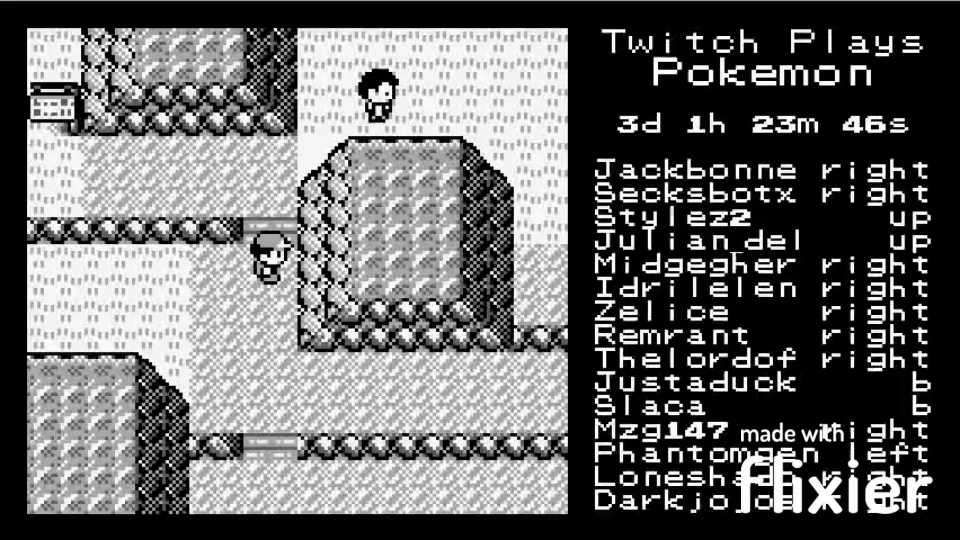
The experiment became even more interesting when the programmer running the stream introduced a mechanic that allowed players to vote for either “Anarchy” or “Democracy” mode. If a majority of votes for Democracy was reached, Democracy mode would activate: every 30 seconds, the most voted-for option would be the single input the game took. This was introduced to help the community with overcoming some difficult sections where they might get stuck (i.e. narrow ledges). Otherwise, if enough people voted for Anarchy, the default way that the game was being played would continue. A large number of people who objected to Democracy mode – believing it ruined the purity of the original, chaotic experience – would spam the Democracy mode vote with input options that stalled progress if it was active (like opening and closing the main menu repeatedly). People were constantly voting and battling for the input mode they preferred.
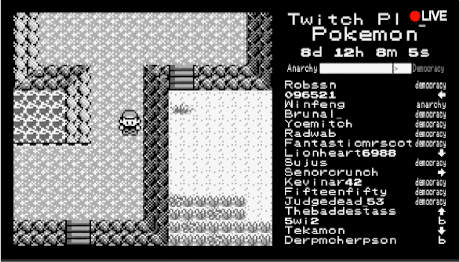
Somehow, some way, the thousands and thousands of people that made up the Twitch hive mind were finally able to beat the game after over 16 continuous days of common struggle. Back in 1996, Pokemon Red was intended to be an adventure experienced by a single player. But, through some clever programming work, this single-player game became a massively multiplayer, collaborative experience. At the same time, it was also competitive, due to some people trying to troll and mess with the hive mind’s progress. All these fascinating aspects of Twitch Plays Pokemon’s format make it one case that especially stands out from Fernández-Vara’s player configurations.
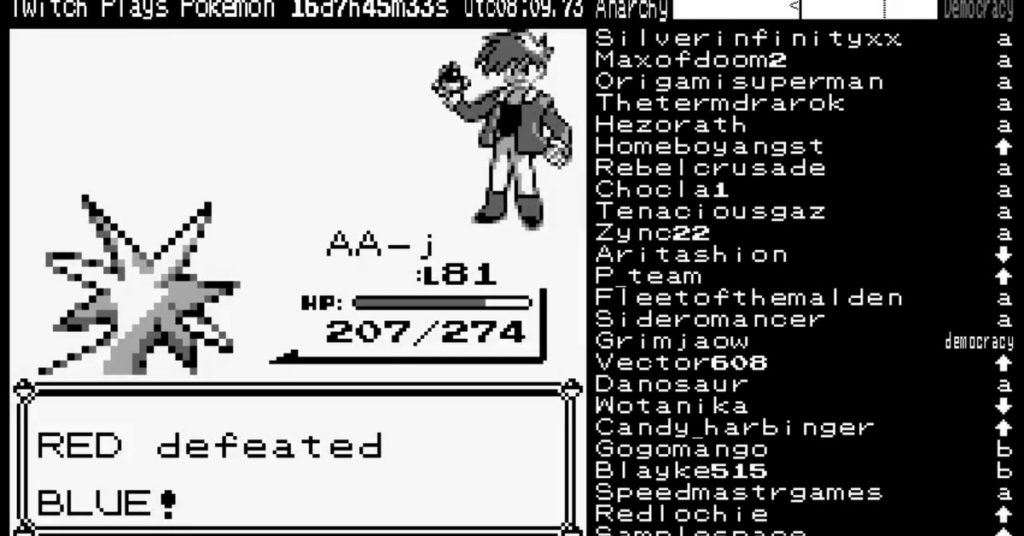
I was fortunate enough to have participated in the Twitch Plays Pokemon phenomenon when it happened live in 2014. It was truly something special to have witnessed, and I’m glad I was there to see it. It was definitely a real “broke the internet” moment in my book. Following the speedrunning communities for some of my favorite games is also a hobby of mine; it’s always a pleasure to see what new tricks are discovered, and what new record times are set. As a result, this post is personal to me as well. Fernández-Vara’s set of “number of players” configurations is certainly a robust and useful set of guidelines for categorizing and analyzing games. However, I hope that with these two examples, I’ve demonstrated that there is still a lot of room for games to be innovative and exist outside these concepts.



Really great blog post! I find it really interesting how these single player games can develop a co-op or multiplayer game mode on their own even if that was not the original intention of the developers just from the fans passion to speed run the game in the case of your speedrunning example where everyone collaborates to find ways to become faster or in the example of twitch plays pokemon where the single player game becomes all the more challenging due to way too many people trying to play the game and input controls all at once. Both of these are great examples of how multiplayer experiences can arise from single-player games and I think says something of how important fan communities are towards developing new ways to experience games! Also, the speedrunning collaboration example reminds me of my own experiences playing teamfight tactics right now (however TFT is definitely a multiplayer game not a single-player game) just on the whole community collaborating to try to develop strategies. Currently, the newest iteration of TFT is out on PBE (Riot’s test server) and on the TFT subreddit many people are theorycrafting and testing out different comps to determine which traits and units are the best and seeing the google sheets for speedrunners just reminded me of the numerous sheets I’ve come across testing out new TFT comps at the moment and that sort of collaboration even in a competitive scenario by making knowledge and resources available to everyone was something that felt very similar!
Thanks for the response! Yeah it’s super interesting how, even in explicitly competitive multiplayer games like TFT, a naturally large amount of collaboration occurs with tutorials, strategies, and builds being shared online. I think stuff like that shows that fan communities of games naturally become very collaborative in nature, even if the game itself is intended to be competitive. And it seems especially true nowadays when people can easily share information and personal creations online on various platforms. Maybe a combination of the internet naturally facilitating the sharing of knowledge and people naturally being a social, collaborative species innately makes this phenomenon so common for multiplayer games.
I’m jealous that you were there for the original Twitch plays Pokemon event. When I first heard of it I was amazed and intrigued by how such chaos and such a sheer amount of people were able to beat a game like Pokemon. I also loved hearing about the community memes like “the Ledge” as you mentioned and how this really gave a sense of community, common struggle, and character to the event that would be very difficult to replicate in the exact same way. Every Twitch plays Pokemon even would have its own difficulties and moments of joy unlike the other. And I like how this really complicates the “Number of Players” and its categories as thousands of players were involved in the Twitch plays Pokemon event which was like making a game out of playing a game. Really great blog post, I found it very interesting.
Appreciate the comment! While the popularity of Twitch Plays Pokemon has definitely calmed down from its height during the first years, it’s still kind of popular as a concept. Streamers sometimes run their own versions of the event to this day, and the official Twitch channel for it still runs streams as well. If you’re ever bored, you can still pop in and check them out every now and then 🙂
This is a really comprehensive blog post- thank you for sharing! I think another interesting part of the whole online multiplayer/singleplayer dichotomy of a community involves the modding community, such as Twitch Plays Pokémon, but also bringing life into old franchises. For example, the Super Smash Brothers Melee community is a vibrant community driven by a game over 20 years ago that brought netcode to a dated game. The homebrewing and modding community too is something that breaths life into older games that bring communities of thousands of people not restricted by hardware.
Thanks for your response! I love the point you bring up about modding and the communities that spring up around it. The fact that people can modify games and distribute these changes online to tons of people is something unique and unmatched in scale compared to things like traditional board games. The Melee scene is a great example; I’m actually quite a big follower of it myself and totally agree haha! Slippi really changed the game, and is another example of people in a competitive community working together for the benefit of their community. The lengths the Melee community has gone to in order to not only survive, but thrive, after over 20 years of existence is incredible. Also, shout-outs to the Mario Kart Wii community, which also has a pretty insane online modding scene.
I love twitch plays pokemon! While I didn’t participate in it myself, I love hearing the legendary highs and lows that came from that game, and I’m glad it’s still a format of play that comes up from time to time.
So, we have single player games that are turned into multi-player games…but what about turning single player games into non-human player games…I’m not talking about COMP vs COMP, but literally a player other than a human person taking control of the game.
I’m referencing, of course, the time that a pet fish played pokemon. https://youtu.be/48-qOC4fCdk
While this is probably entering the realm of spectator-sports in videogames, I just love how creative this was. No human input (as far as I’m aware), just people watching a fish play pokemon in rapt fascination.
I didn’t know about the fish playing Pokemon, that’s honestly amazing haha. Definitely puts an interesting spin on the player-game relationship. Now that you bring it up, though, I do wonder about stuff like COMP vs COMP. What if you could customize the computer players’ difficulties and other settings and watch them go at it, like in Smash or Mario Party? Humans aren’t technically playing the game live, but their inputs and choices can still have an effect on the outcome of a COMP vs COMP match. Also, I saw a video once of a person who had trained their dog to “play” Minecraft by responding to commands and pressing buttons on a customized game pad. The person is the brains behind the operation, but the dog is technically still the one making the inputs. Seems like Fernández-Vara didn’t take human-animal co-op into account! Not sure what categories these fall under, if they can even fit into any of them. Funny examples to think about for sure. Loved the response!